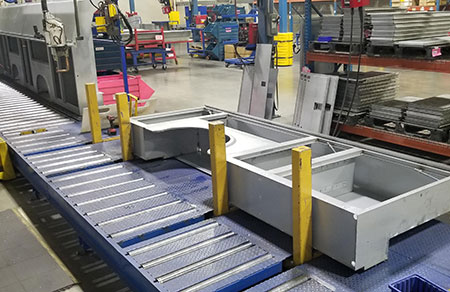We use cookies to make your experience better. To comply with the new e-Privacy directive, we need to ask for your consent to set the cookies. Learn more.
BHS, Inc. Provides Custom Tilt Table for a Knapheide Manufacturing Line
Knapheide Manufacturing Co. has been producing work-ready vehicle solutions since 1848. They have established themselves as the industry leader in the utility truck bed market, and they excel in creating custom solutions for many sectors of the work-vehicle industry.
That kind of success depends on keeping production lines moving. In 2020, Knapheide decided to expand their Quincy, Illinois based manufacturing operations with a high-cycle manufacturing line. Managers reached out to long-time dealer of material handling equipment, John Henry Foster, who in turn contacted an existing partner: BHS, Inc.
This wouldn’t be the first time John Henry Foster, BHS, and Knapheide worked together. In 2018, BHS completed a large project for Knapheide, including rotary Lift Tables and a prototype Tilt Table that became the basis of this latest request. The 2018 Tilt Table was the first of its kind, and BHS made multiple alterations over the next two years to more closely align it with Knapheide’s developing needs.
“BHS continued to make revisions to that first Tilt Table,” David Hughes, outside sales agent at John Henry Foster, said. “They went to whatever length required to keep the customer happy, and they did it because it’s the right thing to do for the customer. They didn’t know it would drive profits, that there’d be a second or third order.”
That second order began in 2020. BHS’ demonstrated devotion to problem-solving made them the perfect partner for Knapheide’s new material handling challenge.
The Problem: Vital Work-Positioning Equipment Replacement
The side-pack assembly area of a Knapheide steel line is where workers build truck-bed compartments. The end-user will eventually use these compartments to store tools, materials, and whatever else they need for the job.
Building side-packs requires a lot of heavy assembly: welding, riveting, industrial adhesives. At one point in the process, workers have to access the underside of the unit, approaching from what will become the completed truck’s wheel well. To make this angle of approach safe and ergonomic, Knapheide requires an enormous Tilt Table that tilts the truck body to a 90-degree angle.
For its first 25 years of operation, this line used an ad-hoc Tilt Table that Knapheide had constructed in-house. But that piece of equipment had reached the end of its service life by 2020.
“It had just been repaired too many times,” said Hughes. “They couldn’t repair it anymore, and they didn’t want to build another Tilt Table in-house.”
Remembering Knapheide’s satisfaction with BHS’ previous work, Hughes reached out to Trent Boothe, senior project manager of engineered systems at BHS. Boothe managed this unique Tilt Table project and the BHS engineers got to work.
The Solution: A Custom Industrial Tilt Table
Engineers at BHS, Inc. took all the lessons of their first Knapheide Tilt Table and applied them to the new unit. The final design would be a 20-foot long platform with 3.3-foot-tall steel L-brackets at irregular intervals. On the operator’s engagement of a foot pedal, the L-brackets tilt 90 degrees, bringing the vertically oriented truck body into a convenient, ergonomic angle. The tilt arms are rated for 2,000 pounds, which is more than enough to handle the truck bodies on the line.

BHS’ 2018 Knapheide Tilt Table handles utility truck bed compartments, tilting them 90° so workers can safely access the underside.
In order to protect the table’s bearings from accumulated metal fragments generated by all the grinding, cutting, and welding, the BHS team took a novel approach. They installed the bearings backwards in their tubes so that the seal faces the inside of the roller, not outwards as in a standard arrangement. This Tilt Table also includes a drift-free roller bed with an air stop, which keeps truck bodies at the precise right placement on the roller bed for the work to be completed efficiently and safely.
Here’s how the Table is designed to work: One side of the Tilt Table’s platform — where workers stand — consists of non-slip tread plate. The opposite side — which holds the truck body — is lined with heavy-duty rollers. Workers roll the body onto the platform, an operator tilts the unit, and then welders and riveters complete their work. When that stage is complete, they tilt the body to the upright position then manually roll it to the next stage on the line.
“As the distributor of this product line, I’ll say that BHS showed great attention to detail and follow-up,” Hughes said of the design.
Implementation:
Knapheide’s Tilt Table order followed BHS’ established Engineered System Sales Order Process:
- Initial Communication. As mentioned, John Henry Foster (the dealer) and BHS (the manufacturer) have an ongoing relationship with Knapheide (the end-user). This order began with a phone call between Knapheide’s leadership and John Henry Foster; then Hughes conveyed the need to Boothe, and the project began.
-
System Evaluation & Detail Gathering. In a sense, this step began long before the 2020 order, when BHS returned to modify the Tilt Table it had provided in 2018. The opportunity to observe a similar unit in action allowed BHS engineers to build a new Tilt Table that would slot into Knapheide’s production line with a minimum of adjustment.
-
System Presentation. Before progressing, the BHS project management team shared the proposed unit with the John Henry Foster team and Knapheide’s decision-makers.
-
Order Conference & System Approval. Once the dealer and end-user had a proposal in hand, all three teams met to discuss every detail of the project, including installation requirements and a comprehensive timeline. Every stakeholder signed off on the project at the conclusion of this meeting.
-
Manufacturing and Quality Assurance. Because the Knapheide custom Tilt Table is a single unit, BHS will build it entirely at their manufacturing facility in nearby St. Louis — no on-site construction necessary. Once complete, the BHS team will run the product through a strict quality assurance process to ensure that it is ready for day-to-day use immediately following installation.
-
Shipping and Installation. The new custom Lift Table is scheduled to be in service by the beginning of 2021. Prior to that, BHS will ship the unit on a flat-bed truck and remain on-hand while John Henry Foster’s team installs the power unit and safety switches.
This Engineered System Sales Order Process has been crafted over decades to efficiently deliver solutions that meet end-user challenges head on. While previous experience working together on a similar project certainly gave BHS a head start on the Knapheide custom Tilt Table, this detailed system helped to ensure the project will be completed as efficiently and transparently as possible.
Results:
As of publication, the BHS manufacturing process is proceeding on schedule. The new Tilt Table will be ready to assist Knapheide’s manufacturers in 2021. Given the unique challenges of this application, only a custom-built unit like BHS’ can do the job.
Knapheide builds 30 or 40 varieties of steel side-packs on the line in question. The demands of utility truck users defy mass-produced homogeneity. “Knapheide customizes many of their utility bodies to meet their customer’s demands,” said Hughes. And this BHS Tilt Table is versatile enough to perform the same work-positioning service for all of the line’s products.
“BHS’ dedication to the customer has been second to none,” Hughes said. “The term is customer service. They went above and beyond and this has continued to drive the relationship...and I’ve already been told that in 2021, a third table will be purchased.”

